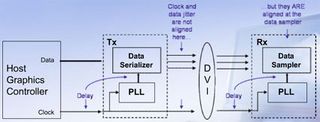The TFT Connection: Do NVIDIA and ATi Deliver?
Causes For Jitter With DVI

As explained before, DVI works at its best when both the transmitter and the receiver are working with the same clock signal and the architecture of both units is identical. However, this is not the case most of the time. This is the reason why DVI can still have its problems despite complex measures such as jitter management.

The image shows an optimal scenario for a DVI transmission. The multiplication of the clock signal by the PLL causes a delay. As a result, the data stream is no longer consistent. This is balanced out by a similar delay in the receiver's PLL, so that the data can be processed correctly.
The DVI 1.0 standard specifies the PLL's delay time exactly. This architecture is called "non-coherent." If a PLL device does not conform to these specifications (delay time), that can lead to problems. Within the industry, a debate is currently raging over whether it makes sense to use such a non-coherent architecture at all, with some parties even calling for a complete revision of the specification.

In this example, the PLL's clock signal is used instead of that of the graphics chip. Consequently, data and clock signal are harmonized. However, due to the delay in the receiver's PLL, the data will be processed incorrectly, and as a result, the DVI jitter management fails!!
In this context, it becomes clear why longer cables can be problematic, even disregarding external signal interference for the moment. If the clock signal is delayed as a result of an overly long cable (data and clock signal are transmitted with different bandwidths), the additional delay can impact the reception of the data in the receiver.
According to the experience of Silicon Image, most 2 meter long DVI cables are OK, but performance varies wildly once you hit 5m (and 10m). We will try to investigate the influence of the cable in a future article.
Stay on the Cutting Edge
Join the experts who read Tom's Hardware for the inside track on enthusiast PC tech news — and have for over 25 years. We'll send breaking news and in-depth reviews of CPUs, GPUs, AI, maker hardware and more straight to your inbox.
Current page: Causes For Jitter With DVI
Prev Page DVI Jitter Management Next Page DVI Transmitter Compliance Test-
Thanks for this. Saved me lots of trouble with (not) chosing an incompatible DVI cable for my monitor / computer connection.Reply
Most Popular

